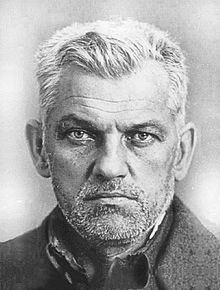Yan Karlovich Berzin

Yan (Ian) Karlovich Berzin (Russian: Ян Карлович Берзин; Latvian: Jānis Bērziņš; real name Pēteris Ķuzis; 25 November [O.S. 13 November 1889] 1889, Kreis Riga (now in Zaube parish), the Russian Empire – 29 July 1938, Moscow, the USSR), was a Latvian Soviet communist politician and military intelligence officer.[1]
Biography[edit]
Ķuzis joined the Russian Social Democratic Labour Party in 1905. According to his former subordinate, Walter Krivitsky, Ķuzis led a guerrilla detachment in his native country of Latvia at the age of 16 during the 1905 Revolution, and was wounded, caught, and sentenced to death.[2] His sentence was commuted because of his youth; after two years in prison, he was deported to Siberia, but escaped. Rearrested and sent back into exile in 1911, he escaped in 1914, and was a private in the Russian army until he deserted in 1916.[1]
Ķuzis joined the Bolsheviks after the Russian Revolution, rising to the rank of general and chief of the Latvian Red Army. From December 1917, he operated in the apparatus of the Cheka and became a principal organizer of Lenin's Red Terror, credited with devising the system of taking and shooting hostages[3] to recover deserters, and to put down peasant rebellions in areas controlled by the Red Army. He was recognized by his superiors for his work in pursuing, arresting, and liquidating Russian sailors after the Bolshevik suppression of the Kronstadt rebellion in March 1921.[3] Promoted to head of the Red Army's Fourth Bureau (military intelligence), the GRU, he served from 1920 to 1935.[3] Among his agents was the prominent German spy Richard Sorge.[4]

He was dismissed in 1935, and served for a year in the Far East. In September 1936, he was sent to Madrid, under the nom de guerre Grishin, as chief military adviser to the Republican side in the Spanish Civil War. In November, he transferred to Valencia. On 8 June 1937, he was recalled to Moscow and was reappointed to his old post as head of military intelligence on 8 June 1937, after his successor Semyon Uritsky had come under suspicion, but on 1 August 1937, he too was dismissed, and was succeeded by A.M. Nikonov, who was also dismissed and arrested a few days later.[5] During the Great Purge as a part of the Latvian Operation of the NKVD, Berzin was arrested by the NKVD on 13 May 1938, and was shot on 29 July 1938.[6]
He was rehabilitated in 1956.
Other details[edit]
On 14 December 1948, Alexander Barmine, former chargé d'affaires at the Soviet embassy in Athens, Greece, advised Federal Bureau of Investigation agents that Berzin informed him prior to Barmine's 1937 defection that Owen Lattimore, the head of the U.S. Office of War Information in the Pacific during World War II, was a Soviet agent.[7]
Berzin appears in the Venona decrypts under the code name "Starik" (Russian: Старик – "Old man").[8][9]
References[edit]
- ^ a b Simkin, John (January 2020). "Yan Berzin". Spartacus Educational.
- ^ Krivitsky, W.G. (1940). I Was Stalin's Agent. London: The Right Book Club. p. 115.
- ^ a b c Suvorov, Viktor (1984) Inside Soviet Military Intelligence, New York: Macmillan
- ^ Agent: Sorge, Richard Archived 2008-07-25 at the Wayback Machine
- ^ Jansen, Marc and Petrov, Nikita (2002). Stalin's Loyal Executioner: People's Commissar Nikolai Ezhov, 1895-1940. Stanford CA: Hoover Institution Press. pp. 66–67. ISBN 978-0-8179-2902-2.
{{cite book}}: CS1 maint: multiple names: authors list (link) - ^ Nordlander, David J. (Winter, 1998) "Origins of a Gulag Capital: Magadan and Stalinist Control in the Early 1930s," Slavic Review, Vol. 57, No. 4, pp. 791-812
- ^ FBI Report, "Owen Lattimore, Internal Security - R, Espionage - R," September 8, 1949 (FBI File: Owen Lattimore, Part 1A), p. 2 (PDF p. 7)
- ^ Herbert Romerstein and Eric Breindel, The Venona Secrets: Soviet Espionage and America's Traitors (Washington, DC: Regnery Publishing, 2000), ISBN 0895262754, p. 119
- ^ Chambers, Whittaker (1952). Witness. Washington, D.C.: Regnery Publishing, Inc. pp. 398–400. ISBN 9780895267894.
External links[edit]
- 1889 births
- 1938 deaths
- People from Cēsis Municipality
- People from Kreis Riga
- Bolsheviks
- Executive Committee of the Communist International
- Cheka officers
- Cheka
- GRU officers
- Russian military personnel of World War I
- Latvian people of the Spanish Civil War
- Soviet people of the Spanish Civil War
- Perpetrators of the Red Terror (Russia)
- Recipients of the Order of Lenin
- Recipients of the Order of the Red Banner
- Recipients of the Order of the Red Star
- Latvian Operation of the NKVD
- Great Purge victims from Latvia
- Soviet rehabilitations

